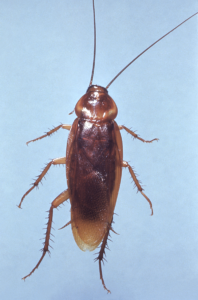American Cockroaches
Periplaneta americana
Color: It is bright brown and red.
Shape:It has an oval structure. They have short distance flight capabilities.
Size: 35-50 mm in length.
Diet: They like food such as garbage, food scraps, starch, sweets, paper and glue.
Geographical Range: They are widespread globally and like tropical climates more
Habitat: Sewers are found in humid and warm environments. They thrive in kitchens and similar humid environments.

American Cockroaches Behavior?
Activity Pattern
- They are more active at night. During the day they tend to wait in dark and warm areas. They are fast runners.
Flight Behavior
- They have the ability to fly. But they usually prefer to walk and can fly well over short distances.
Social Behavior
- They usually live in colonies. They colonize large areas such as sewers and basements. They use pheromones to find each other.
Response to Threats
- They escape into cracks and crevices. When in difficulty, they escape with their flight skills. They move quickly away from sudden light and bright areas.
Reproduction and Nesting
- Females lay more than one egg case. Their reproduction rate is very high in warm and humid environments.
Feeding Behavior
- They feed on anything organic. They like rotten foods, starch, sugary foods.
Environmental Adaptability
- Survival Skills: They can live without food for about 1 month and without water for about 1 week.
Threats from American Cockroaches
Disease Transmission
- Salmonella: Causes food poisoning.
- E. coli: Can lead to severe gastrointestinal illness.
- Dysentery and Cholera: Spread through contamination of food and water.
Infestation Risks
- Rapid Reproduction: When they find the right conditions for reproduction, they reproduce very quickly and form colonies.
- Hard-to-Reach Locations: They invade hard-to-reach areas such as cracks and crevices and become very difficult to control.
Signs of an Infestation
- Sightings: Seeing live cockroaches during the day can be a sign of a major infestation. Seeing dead cockroaches is one of the signs of active infestation.
- Droppings: Their droppings are small, dark in color and cylindrical. They are often confused with rat droppings.
- Locations: Dark and hidden corners should be checked in food storage areas.
- Egg Cases (Oothecae): Reddish brown capsule 8-10 mm long.
- Odor: A greasy and musty smell is often emitted.
- Damage to Materials: Nutrition signs are observed in products such as books, cardboard, fabrics.
- Food Contamination: Partially eaten food and feces found in the area can be a sign.
If you observe any of these signs, it is urgent to seek professional help to prevent an infestation. Early intervention is crucial to prevent an infestation.
